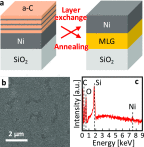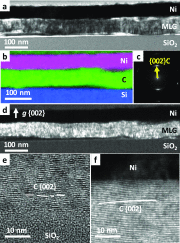Impact of Amorphous-C/Ni Multilayers on Ni-Induced Layer Exchange for Multilayer Graphene on Insulators
- PMID: 31508548
- PMCID: PMC6733173
- DOI: 10.1021/acsomega.9b01708
Impact of Amorphous-C/Ni Multilayers on Ni-Induced Layer Exchange for Multilayer Graphene on Insulators
Abstract
Layer exchange growth of amorphous carbon (a-C) is a unique technique for fabricating high-quality multilayer graphene (MLG) on insulators at low temperatures. We investigated the effects of the a-C/Ni multilayer structure on the quality of MLG formed by Ni-induced layer exchange. The crystal quality and electrical conductivity of MLG improved dramatically as the number of a-C/Ni multilayers increased. A 600 °C-annealed sample in which 15 layers of 4-nm-thick a-C and 0.5-nm-thick Ni were laminated recorded an electrical conductivity of 1430 S/cm. This value is close to that of highly oriented pyrolytic graphite synthesized at approximately 3000 °C. This improvement is likely related to the bond weakening in a-C due to the screening effect of Ni. We expect that these results will contribute to low-temperature synthesis of MLG using a solid-phase reaction with metals.
Conflict of interest statement
The authors declare no competing financial interest.
Figures



Similar articles
-
High-Electrical-Conductivity Multilayer Graphene Formed by Layer Exchange with Controlled Thickness and Interlayer.Sci Rep. 2019 Mar 11;9(1):4068. doi: 10.1038/s41598-019-40547-0. Sci Rep. 2019. PMID: 30858422 Free PMC article.
-
Metal Catalysts for Layer-Exchange Growth of Multilayer Graphene.ACS Appl Mater Interfaces. 2018 Dec 5;10(48):41664-41669. doi: 10.1021/acsami.8b14960. Epub 2018 Nov 19. ACS Appl Mater Interfaces. 2018. PMID: 30403335
-
Layer exchange synthesis of multilayer graphene.Nanotechnology. 2021 Sep 2;32(47). doi: 10.1088/1361-6528/ac1d05. Nanotechnology. 2021. PMID: 34384058 Review.
-
Low-Temperature (400 °C) Synthesis of Multilayer Graphene by Metal-Assisted Sputtering Deposition.ACS Omega. 2019 Apr 11;4(4):6677-6680. doi: 10.1021/acsomega.9b00420. eCollection 2019 Apr 30. ACS Omega. 2019. PMID: 31459793 Free PMC article.
-
Graphene-based multilayers constructed from layer-by-layer self-assembly techniques.J Nanosci Nanotechnol. 2014 Feb;14(2):1145-53. doi: 10.1166/jnn.2014.9110. J Nanosci Nanotechnol. 2014. PMID: 24749418 Review.
References
-
- Murali R.; Yang Y.; Brenner K.; Beck T.; Meindl J. D. Breakdown Current Density of Graphene Nanoribbons. Appl. Phys. Lett. 2009, 94, 24311410.1063/1.3147183. - DOI
LinkOut - more resources
Full Text Sources
